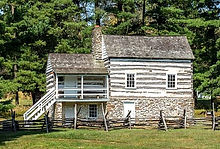External Links
Some other places to visit, in person or online, for experiencing John Brown history.

John Brown House:
Akron, Ohio
Now-renovated home that John Brown and his family began renting in 1844 from Colonel Simon Perkins of the founding family of Akron. Brown ran a sheep farm for Perkins as part of a wool business that the two men formed. The Perkins Stone Mansion, and the John Brown House across from it, are properties of the Summit County Historical Society of Akron.

John Brown Farm State Historic Site:
Lake Placid, New York
John Brown’s last homestead. He moved his family there in 1849 to assist a community of free blacks with farming. It became his burial place after Brown was hanged for his 1859 raid on the federal arsenal at Harpers Ferry. The site is maintained by the State of New York. The public can tour the farmhouse, use recreational trails on the grounds, and see a statue of Brown that memorializes his grave and those of some of his Harpers Ferry followers.

John Brown Museum State Historic Site:
Osawatomie, Kansas
Features the preserved Adair cabin that was a station on the Underground Railroad and provided Brown a headquarters in his armed campaigns to keep Kansas from becoming a slave state. The Rev. Samuel Adair and his wife, Florella, a half-sister of John Brown, were anti-slavery missionaries in Kansas. The cabin today is a museum, located in a park on the site where Brown clashed with pro-slavery forces at the “Battle of Osawatomie” in 1856. The John Brown Museum is a partnership of the Kansas Historical Society and the City of Osawatomie.

Freedom Trail:
Tabor, Iowa, and 15 other sites in state
The path taken in February–March 1859 by John Brown and several of his followers while escorting 12 men, women and children whom they had freed from slavery in Missouri. They stopped at the antislavery community of Tabor and at 15 other locations in Iowa before putting the escaped slaves on a ferry to freedom in Canada. Their trek is included in the Iowa Freedom Trail Project devoted to researching the state’s Underground Railroad history.

John Brown House:
Chambersburg, Pennsylvania
Originally the Mary Ritner Boarding House. John Brown, under the alias of Isaac Smith, stayed there during the summer of 1859 while secretly lining up supplies, weapons and recruits for his plan to raid the federal arsenal at Harpers Ferry. The house is available for the public to tour and is operated by the Franklin County Historical Society.

The Kennedy Farmhouse/John Brown Raid Headquarters:
Sharpsburg, Maryland
The small rental house that served as a hideout for John Brown and his men to assemble, train and plan for the Harpers Ferry raid. Known as the Kennedy farmhouse, the two-story building on the Maryland side of Harpers Ferry has been restored by the private nonprofit John Brown Historical Foundation. Guided tours of the property are available by appointment.

Harpers Ferry National Historical Park:
Harpers Ferry, West Virginia
Site of the industrial village, then part of Virginia, where a U.S. armory operated. On Oct. 16, 1859, the complex became invaded by John Brown and 21 white and black followers who sought to seize weapons from the arsenal and spread a slave revolt in the South. The National Park Service at Harpers Ferry administers 3,500 acres in West Virginia, Virginia and Maryland. The park encompasses a visitor center, nature attractions, hiking trails, Civil War sites, and historic buildings that offer museum exhibits and demonstrations of 19th century trades. The buildings include the fire engine house of the armory where, with several of his raiders, John Brown barricaded himself before being wounded and captured by U.S. troops.

Walking Tour of Charles Town:
Charles Town, West Virginia
Seat of Jefferson County (in Virginia then), where John Brown and six of the other surviving Harpers Ferry raiders were taken after their capture. Tour stops include the courthouse where the raiders were tried, convicted on criminal charges, and sentenced to hang; the site of the former open field where the executions took place; and a museum that contains the wagon that carried John Brown to the gallows.
